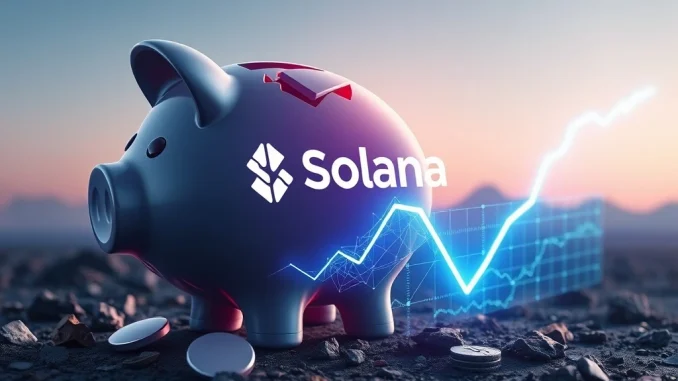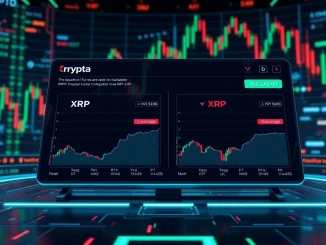
The cryptocurrency world is no stranger to volatility, but a recent announcement from Asymmetric Financial, a prominent crypto hedge fund, has sent ripples across the market. After facing intense scrutiny over significant investor losses, the firm is making a dramatic shift, abandoning its liquid strategies to focus on long-term investments in Solana infrastructure. What does this mean for the future of crypto investments, and why is Solana at the heart of this pivotal change?
What Led to Asymmetric Financial’s Bold Move?
The catalyst for this major strategic overhaul was the reported 78% decline in value of Asymmetric Financial’s Liquid Alpha Fund in 2025. This staggering loss, which came under intense public scrutiny, particularly after a viral X (formerly Twitter) post by an investor named BigbrainSOL highlighting a $10 million portfolio drop, forced the firm’s hand. CEO Joe McCann openly acknowledged the fund’s underperformance, stating it “failed to deliver this year.” The decision to close the Liquid Alpha Fund and redirect capital signals a clear response to market pressures and investor dissatisfaction. This move by Asymmetric Financial highlights the growing influence of social media in shaping institutional decisions, demonstrating how public accountability can drive rapid action in volatile markets.
Why Abandon Liquid Strategies Now?
For years, many crypto hedge funds have thrived on high-leverage liquid strategies, aiming for quick gains in a rapidly moving market. However, Asymmetric Financial’s experience serves as a stark reminder of the inherent risks. The firm’s substantial investor losses underscore how quickly fortunes can turn during market downturns. Liquid strategies, while offering high potential returns, also expose funds to extreme volatility and sudden price swings, making them susceptible to significant drawdowns. The closure of the Liquid Alpha Fund, reportedly losing $100 million, illustrates the cautionary tale for firms heavily reliant on short-term volatility. This strategic pivot reflects a broader industry recalibration, with firms seeking more stable returns amid ongoing market fluctuations.
The Future is Solana Infrastructure: A New Horizon?
The pivot sees Asymmetric Financial channeling its capital into illiquid investments, with a strong emphasis on blockchain infrastructure projects, particularly within the Solana ecosystem. This shift towards Solana infrastructure is a significant vote of confidence in the network’s long-term potential. Infrastructure projects, such as layer-2 solutions, DeFi protocols, and other foundational technologies, are increasingly viewed as a more stable asset class compared to speculative liquid assets. Analysts suggest this focus could position Asymmetric to capitalize on the growing appeal of robust, utility-driven blockchain components. While the firm has not disclosed specific projects, the move aligns with narratives around crypto’s maturation, prioritizing resilience and long-term growth over high-risk gains.
Navigating Investor Losses: Redemption or Reinvestment?
Following the announcement, investors in Asymmetric’s affected funds have been given options: they can redeem their capital or transition their holdings into the new illiquid opportunities, bypassing customary lock-up periods. This flexibility aims to mitigate the impact of the investor losses and maintain trust. However, investors opting for illiquid offerings should be aware of potential extended lock-up periods, underscoring the trade-off between risk mitigation and liquidity. The success of this transition hinges not only on the performance of the new $1 billion Solana initiative but also on broader market stability and the firm’s execution of its new strategy.
What Does This Mean for the Crypto Hedge Fund Landscape?
Asymmetric Financial‘s dramatic pivot sends a strong signal across the entire crypto hedge fund landscape. It highlights the evolving nature of institutional crypto investment, moving away from purely speculative ventures towards more foundational, utility-focused projects. While Asymmetric faced a significant setback, CEO Joe McCann emphasized the firm’s commitment to remaining operational, noting that other fund vehicles have performed well. This adaptability is crucial in a rapidly evolving industry that navigates constant regulatory and economic challenges. The incident underscores that even established players must be agile and responsive to market realities and public sentiment, prioritizing resilience and sustainable growth over high-risk, short-term gains.
Asymmetric Financial’s strategic pivot is more than just a firm’s response to losses; it’s a microcosm of the broader crypto market’s maturation. The shift from volatile liquid strategies to foundational Solana infrastructure investments reflects a growing emphasis on stability, utility, and long-term value. While the road ahead will certainly have its challenges, this bold move by Asymmetric Financial could pave the way for a new era of institutional investment in the blockchain space, prioritizing robust development over speculative trading. It serves as a compelling reminder that even in the fast-paced world of crypto, adaptability and a focus on core infrastructure are paramount for enduring success.
Frequently Asked Questions (FAQs)
Q1: Why did Asymmetric Financial pivot from liquid strategies?
A1: Asymmetric Financial pivoted after its Liquid Alpha Fund reportedly lost 78% of its value in 2025, leading to significant investor losses and public scrutiny. The firm aims to move away from high-risk, short-term trading to more stable, long-term infrastructure investments.
Q2: What is Solana infrastructure, and why is Asymmetric Financial investing in it?
A2: Solana infrastructure refers to the foundational technologies, protocols, and applications built on the Solana blockchain, such as DeFi protocols, layer-2 solutions, and developer tools. Asymmetric Financial is investing in it because these illiquid projects are seen as a more stable asset class, offering long-term growth potential and reduced exposure to market volatility compared to liquid trading.
Q3: What options do investors have following this pivot?
A3: Investors in Asymmetric’s affected funds are permitted to redeem their capital or transition their holdings into the new illiquid opportunities, bypassing customary lock-up periods. This offers them a choice between exiting or re-engaging with the firm’s new strategy.
Q4: How did social media influence Asymmetric Financial’s decision?
A4: A viral post on X (formerly Twitter) by an investor, BigbrainSOL, revealing a $10 million portfolio drop, fueled widespread criticism and public accountability. This amplified pressure on Asymmetric Financial, contributing to their rapid decision to pivot strategies.
Q5: Does this pivot indicate a broader trend in the crypto hedge fund industry?
A5: Yes, analysts suggest this shift reflects a sector-wide recalibration. More crypto firms are increasingly targeting infrastructure projects to stabilize returns and prioritize resilience over high-risk gains, signaling a maturation of the institutional crypto investment landscape.



